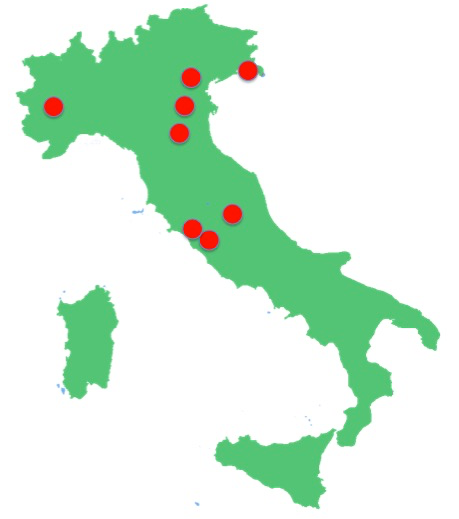Scientific activities of the various Research Units
Bologna
The InDark group in Bologna includes researchers interested in a wide range of topics, such as Inflation and Early Universe, physics of the cosmic microwave background, galaxy surveys, clusters of galaxies and gravitational lensing. Members of the group are involved in- the Planck collaboration, contributing to data analysis and coordinating the scientific interpretation in the context of inflation, and being heavily involved in cosmological parameters, primordial magnetic fields, isotropy and statistics, dark energy studies.
- development of theoretical models and data analysis tools in the context of dark energy, with particular emphasis to the EUCLID and VIPERS collaborations.
Ferrara
The InDark group in Ferrara is mainly involved in the following research topics:- Massive Gravity Theories.
Infrared Gravity modifications call for new degrees of freedom. We analyze the theories of gravity modified by a generic non derivative potential built from the metric. Using canonical analysis, we have classified the potentials according to the number of degrees of freedom (DoF) that propagate. We are trying to merge the above effective field theory approach inside a more general Higgs mechanism for gravitational theories. - CMB.
Development of algorithms and their application to CMB data analysis.
LNGS
The main research activities are:- Massive Gravity:
In massive gravity theories the graviton field has a modified dispersion relation and new degrees of freedom can be present. Cosmological observations are used to probe such modifications at large distances where Dark Energy and Dark Matter are required in GR. The effective field theory approach is successful to get the low energy structure of these models, however to make solid predictions in the very early universe one need to go beyond a low energy theory. A gravitational Higgs mechanism (still missing) is under study. - Neutrinos:
Theory and phenomenology of neutrinos from astrophysical sources; phenomenology of UHE neutrinos and their detection in neutrino telescopes; analysis of the solar composition problem and of future CNO solar neutrino measurement. Particle and nuclear physics studies of BBN.
Padova
The members of the InDark group in Padova mainly focus on the following research activities:- inflationary models and their observational predictions for the generation of the primordial density perturbations; primordial non-Gaussianity; non-Gaussianity of the CMB and of the LSS; generation of a stochastic background of primordial gravitational waves; anisotropic cosmological models.
- models for DE and modified gravity, forecasts and confrontation with CMB and LSS observations.
- LSS modelling, linear and non-linear evolution of cosmological perturbations
- implementations of statistical tools to various dataset, focusing in particular to non-Gaussianity. The researchers of the group are members of the Planck collaboration (coordinating the non-Gaussianity analyses and scientific interpretation of inflationary models from non-Gaussianity, and being heavily involved in the Planck activities related to inflation, ISW-lensing and component separation) and are involved in the EUCLID collaboration. They are also part of the cosmology working group of the LISA satellite.
Roma II
The main research activity of this node consists in the analysis of available cosmological data (CMB, galaxy surveys, distance indicators) with the goal of learning about fundamental physics, in particular with respect to aspects related to the early universe and the matter and energy content of the universe. We also apply our tools to realistic simulations of future observations in order to understand how much additional knowledge we can learn from forthcoming information.Roma III
- Analysis of the LSS in the Universe to investigate the nature of the cosmic acceleration and put constraints on dark energy and modified gravity models. This unit contributes to this effort by developing, implementing and testing new tools to analyse the statistical properties of galaxy clustering in currently available and future large datasets such as the Euclid satellite mission.
- Constraints on dark matter from the diffuse extragalactic gamma-ray background. The maps of the diffuse gamma ray background that are being produced by the Fermi satellite provide a unique possibility to both constrain the nature and abundance of dark matter and, more in general, to investigate the origin of this diffuse signal. The angular correlation signature of the dark matter can be enhanced by cross-correlating the gamma ray maps with the angular distribution of any dark matter tracer. The same technique (pioneered by by Xia et al. (2011)) can also be used to detect the contribution from unresolved astrophysical sources. We are in the process of applying it to the latest Fermi maps.
- Testing theoretical models for missing baryons on the local Universe.
Torino
- We are involved in HectoMAP, an international collaboration to compile a dense galaxy redshift survey out to redshift 0.8. In addition, we test extended and modified gravity models at various scales and epochs with extensive observational data sets.
- We investigate the formation and evolution of galaxies, clusters and larger structures with N-body/hydrodynamical simulations and multi-wavelength observations. We have developed the caustic technique, a unique method to estimate the mass of galaxy clusters well beyond the region of dynamical equilibrium. The method is based on galaxy redshifts alone and is complementary to gravitational lensing.
- We develop novel observables and methods capable of exploiting the information from future experiments at its best. For instance, we investigate cross-correlations between optical and radio surveys, such as the ESA Euclid satellite and the Square Kilometre Array, to access the largest cosmic scales, where inflation and general relativity can be best tested.
Trieste
-
The scientific activities of the Trieste node are:
- constraints on the mass of neutrinos from cosmological data and modelling of neutrino fluid with N-body/hydro simulations;
- constraints on cold dark matter coldness at small scales;
- the high redshift universe in 21 cm intensity mapping (general relativistic effects and non-gaussianity), with forecasts for SKA;
- cosmological parameters in standard and non-standard cosmologies (dark energy cosmologies, modified gravity and warm dark matter);
- characterization of the physical and chemical properties of galaxy clusters; galaxy clusters as cosmological probes; analysis of galaxy clustering (Euclid mission).
- We study CMB anisotropies, specifically the effects of (i) inflationary gravitational waves and (ii) gravitational lensing by LSS in CMB polarization (related to Dark energy and Matter). We have data analysis and simulation lead roles in the following CMB experiments: EBEX Planck, PolarBear/Simons Array, Simons Observatory. For LSS, we're part of the SDSS and we've coordination roles in the forthcoming ESA satellite, Euclid.
^ Back to Top


